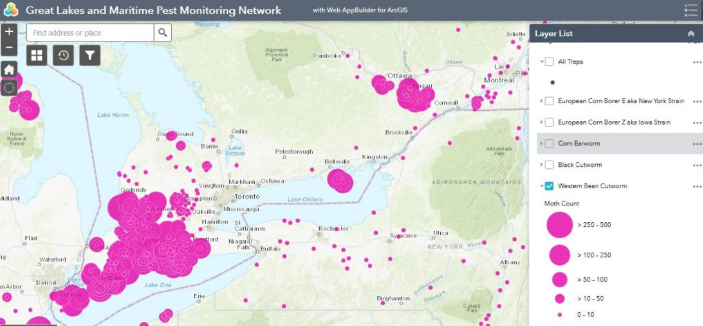Western bean cutworm (WBC)
Peak moth flight is likely taking place this week for many regions of Ontario, putting both corn and dry beans at risk (Figure 1). WBC moths prefer pre-tassel to full tassel corn to lay eggs in so scout these fields first. If corn has passed these stages in the immediate area, moths will choose to lay eggs in dry beans instead. In corn, it is best to scout every 5 days for three weeks in a row around peak flight. Egg masses found during the previous scouting trip will be close to hatching (purple in colour) while new egg masses will be white to tan in colour. Egg masses have been difficult to find again this year in corn fields despite high trap catches. Scouting before making a spray decision can save both money and the natural enemies that are doing the job for you. If after three scouting trips, a cumulative 5% of the plants scouted have egg masses on them, a spray is required during fresh silk stage.

In dry beans, scouting for WBC is much more difficult and can be misleading. Fields with no signs of WBC presence during scouting can still result in WBC damaged seed at harvest. If traps have captured more than 150 moths, fields should be scouted. Scouting for early signs of pod feeding is recommended 10 to 20 days after peak flight once pods are forming on the plants. If adjacent corn fields have reached threshold, the dry bean field likely also requires management in early to mid-pod stages.
Corn earworm (CEW)
Larvae are showing up in some sweet corn ears and are likely also in some grain corn. Moths have been captured in Ontario and neighbouring jurisdictions for several weeks now. Corn earworm adults are attracted to later planted fields during early green silk stage. Adults lay eggs on individual corn silk hairs so scouting for eggs is impossible. While scouting for WBC, watch for signs of CEW ear feeding, usually noticeable if silks appear thin or absent. Open ears to inspect for larvae. If young CEW larvae are present and the field is nearing the WBC threshold, spraying during fresh silks would help control CEW as well.
Corn Rootworm
Adultsare abundant in many corn fields. Adults can clip silks and impede pollination (Figure 2). If adults are clipping silks to 1.25 cm (0.5 in.) or less and 10 or more adults per plant are present before 50% pollination, a spray is required. Especially if the fields are stressed from dry weather conditions. In continuous corn fields, if 1 or more adults per plant are present in August, this is an indication that protection will be required in next year’s corn crop (ie. seed treatment, granular insecticide and/or Bt hybrid). If signs of goosenecking injury and adults are showing up in Bt rootworm hybrids this year, please contact your seed agronomist and Tracey Baute at OMAFRA to further investigate whether the population has developed resistance to the Bt trait.
Japanese beetles
Are abundant this year and like rootworm, can clip corn silks. If there are three or more beetles per plant and silks are being clipped to 1.25 cm (0.5 in.) or less before 50% pollination, spray is warranted.
Both rootworms and Japanese beetles can feed on soybeans. Some random caterpillars are also being found in soybeans (though at very low levels). No matter which insect is feeding on soybean leaves, it is the percentage of defoliation that matters.
The most critical stage for soybeans is bloom (R1) to pod-fill (R4), when seed development is highly dependent on photosynthesis. In 10 areas of the field, pick trifoliate leaves from five plants in the middle of the plant’s canopy. Discard the least and most damaged leaflets from each trifoliate collected, leaving only one leaflet for each trifoliate collected. Visually move all the holes to one end of the leaf and determine how much of the leaf is gone (Figure 3). Spray is warranted only if threshold has been reached for that crop stage (Table 1).
Table 1. Soybean Defoliation Thresholds (Source: Agronomy Guide for Field Crops, Publication 811)
Source : Field Crop News